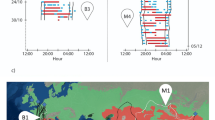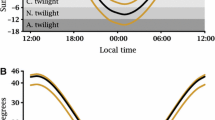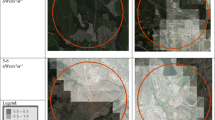Abstract
Upon leaving their natal area, dispersers are confronted with unknown terrains. Species-specific perceptual ranges (i.e. the maximum distance from which an individual can perceive landscape features) play a crucial role in spatial movement decisions during such wanderings. In nocturnal animals that rely on vision, perceptual range is dramatically enhanced during moonlight, compared to moonless conditions. This increase of the perceptual range is an overlooked element that may be responsible for the successful crossing of unfamiliar areas during dispersal. The information gathered from 143 radio-tagged eagle owl Bubo bubo juveniles in Spain, Finland and Switzerland shows that, although the decision to initiate dispersal is mainly an endogenous phenomenon determined by the attainment of a given age (∼6 months), dispersers leave their birthplace primarily under the best light conditions at night, i.e. when most of the lunar disc is illuminated. This sheds new light into the mechanisms that may trigger dispersal from parental territory.

Similar content being viewed by others
References
Aebischer A, Nyffeler P, Arlettaz R (2010) Wide-range dispersal in juvenile Eagle Owls (Bubo bubo) across the European Alps calls for transnational conservation programmes. J Ornithol 151:1–9
Belthoff JR, Dufty AM Jr (1995) Locomotor activity levels and the dispersal of western screechowls, Otus kennicottii. Anim Behav 50:558–561
Belthoff JR, Dufty AM Jr (1998) Corticosterone, body condition and locomotor activity: a model for dispersal in screech-owls. Anim Behav 55:405–415
Bonte D, Van Dyck H, Bullock JM, Coulon A, Delgado MM et al (2012) Costs of dispersal. Biol Rev 87:290–312
Brigham RM, Barclay RMR (1992) Lunar influence on foraging and nesting activity of common whippoorwills (Phalaenoptilus nuttallii). Auk 109:315–320
Brown FA (1972) Clocks timing biological rhythms. Am Sci 60:756–766
Bulyuk VN, Mukhin A, Kishkinev D, Kosarev V (2009) To what extent do environmental factors affect the long-distance nocturnal post-fledging movements of the Reed Warbler? J Ornithol 150:339–350
Bunn DS, Warburton AB, Wilson RDS (1982) The barn owl. Buteo Books, Vermillion
Clarke JA (1983) Moonlights influence on predator prey interactions between short-eared owls (Asio flammeus) and deermice (Peromyscus maniculatus). Behav Ecol Sociobiol 13:205–209
Crawley MJ (2007) The R book. Wiley, Chichester
Danthanarayana W (1986) Lunar periodicity of insect flight and migration. In: Danthanarayana W (ed) Insect flight: dispersal and migration. Springer, Berlin, pp 88–119
de Bruyn AMH, Meeuwig JJ (2001) Detecting lunar cycles in marine ecology: periodic regression versus categorical ANOVA. Mar Ecol Prog Ser 214:307–310
de Laet JV (1985) Dominance and aggression in juvenile great tits, Parus major major L. in relation to dispersal. In: Sibly RM, Smith RH (eds) Behavioral ecology: ecological consequences of adaptive behavior. Blackwell, Oxford, pp 375–380
Delgado MM, Penteriani V (2008) Behavioral states help translate dispersal movements into spatial distribution patterns of floaters. Am Nat 172:475–485
Delgado MM, Penteriani V, Revilla E, Nams VO (2010) The effect of phenotypic traits and external cues on natal dispersal movements. J Anim Ecol 79:620–632
Ellsworth EA, Belthoff JR (1999) Effects of social status on the dispersal behaviour of juvenile western screech-owls. Anim Behav 57:883–892
Fernandez-Duque E, de la Iglesia H, Erkert HG (2010) Moonstruck primates: owl monkeys (Aotus) need moonlight for nocturnal activity in their natural environment. PloS ONE 5:e12572
Gerrish GA, Morin JG, Rivers TJ, Patrawala Z (2009) Darkness as an ecological resource: the role of light in partitioning the nocturnal niche. Oecologia 160:525–536
Hasegawa EI (2012) Chum salmon Oncorhynchus keta respond to moonlight during homeward migrations. J Fish Biol 81:632–641
James D, Jarry G, Erard C (2000) Influence of the moon on the nocturnal postnuptial migration of the skylark Alauda arvensis L. in France. CR Acad Sci III Vie 323:215–224
Johst K, Brandl R (1997) Evolution of dispersal: the importance of the temporal order of reproduction and dispersal. Proc R Soc Lond B 264:23–30
Johst K, Brandl R (2000) Evolution of age specific dispersal: a general discussion from the standpoint of the invasion fitness concept. Web Ecol 1:82–85
Kenward RE, Marcström V, Karlbom M (1993) Post-nesting behaviour in goshawks, Accipiter gentilis: I. The causes of dispersal. Anim Behav 46:365–370
Kotler BP, Brown JS, Hasson O (1991) Factors affecting gerbil foraging behavior and rates of owl predation. Ecology 72:2249–2260
Kotler BP, Brown J, Mukherjee S, Berger-Tal O, Bouskila A (2010) Moonlight avoidance in gerbils reveals a sophisticated interplay among time allocation, vigilance and state-dependent foraging. Proc R Soc Lond B 277:1469–1474
Kuparinen A, Klefoth T, Arlinghaus R (2010) Abiotic and fishing-related correlates of angling catch rates in pike (Esox lucius). Fish Res 105:111–117
Leatherland JF, Farbridge KJ, Boujard T (1992) Lunar and semi-lunar rhythms in fishes. In: Ali MA (ed) Rhythms in fishes. Plenum Press, New York, pp 83–107
Lima SL, Zollner PA (1996) Towards a behavioral ecology of ecological landscapes. Trends Ecol Evol 11:131–135
Martin G (1990) Birds by night. Poyser, London
Mukherjee S, Zelcer M, Kotler BP (2009) Patch use in time and space for a meso-predator in a risky world. Oecologia 159:661–668
Nilsson J-A (1990) Family flock break-up: spontaneous dispersal or parental aggression? Anim Behav 40:1001–1003
Nilsson J-A, Smith HG (1985) Early fledgling mortality and the timing of juvenile dispersal in the marsh tit Parus palustris. Ornis Scand 16:293–298
Penteriani V, Delgado MM (2011) Birthplace-dependent dispersal: are directions of natal dispersal determined a priori? Ecography 34:729–737
Penteriani V, Kuparinen A, Delgado MM, Lourenco R, Campioni L (2011) Individual status, foraging effort and need for conspicuousness shape behavioural responses of a predator to moon phases. Anim Behav 82:413–420
Penteriani V, Kuparinen A, Delgado MM, Palomares F, López-Bao JV et al (2013) Responses of a top and a meso predator and their prey to moon phases. Oecologia 173:753–766
Pienkowski MW (1982) Diet and energy-intake of grey and ringed plovers, Pluvialis squatarola and Charadrius hiaticula, in the non-breeding season. J Zool 197:511–549
Pinheiro J, Bates D, DebRoy S, Sarkar D, the R Core team (2009) nlme: linear and nonlinear mixed effects models. R package version 3.1-96, http://cran.r-project.org/web/packages/nlme/nlme.pdf
R Development Core Team (2009) R: a language and environment for statistical computing. R Foundation for Statistical Computing, Vienna, Austria. ISBN 3-900051-07-0, URL: http://www.R-project.org
Richardson WJ (1978) Timing and amount of bird migration in relation to weather—review. Oikos 30:224–272
Ritchison G, Belthoff JR, Sparks EJ (1992) Dispersal restlessness: evidence for innate dispersal by juvenile eastern screech-owls? Anim Behav 43:57–65
Saunders RA, Royer F, Clarke MW (2011) Winter migration and diving behaviour of porbeagle shark, Lamna nasus, in the Northeast Atlantic. Ices J Mar Sci 68:166–174
Scapini F, Audoglio M, Chelazzi L, Colombini I, Fallaci M (1997) Astronomical, landscape and climatic factors influencing oriented movements of Talitrus saltator in nature. Mar Biol 128:63–72
Schaub M, Aebischer A, Gimenez O, Berger S, Arlettaz R (2010) Massive immigration balances high anthropogenic mortality in a stable eagle owl population: lessons for conservation. Conserv Biol 143:1911–1918
Silverin B (1997) The stress response and autumn dispersal in willow tits. Anim Behav 53:451–459
Strickland D (1991) Juvenile dispersal in gray jays: dominant brood member expels siblings from natal territory. Can J Zool 69:2935–2945
Trillmich F, Mohren W (1981) Effects of the lunar cycle on the galapagos fur-seal, Arctocephalus galapagoensis. Oecologia 48:85–92
Veltman CJ (1989) Effects of experimental food addition on post-natal dispersal, polygyny, and reproductive success in pair-defended territories of the Australian magpie (Gymnorhina tibicen). Ardea 77:211–216
Wiggett DR, Boag DA (1993) The proximate causes of male-biased natal emigration in Columbian ground squirrels. Can J Zool 71:204–218
Wingfield JC, Ramenofsky M (1997) Corticosterone and facultative dispersal in response to unpredictable events. Ardea 85:155–166
Zollner PA, Lima SL (1997) Landscape-level perceptual abilities in white-footed mice: perceptual range and the detection of forested habitat. Oikos 80:51–60
Zollner PA, Lima SL (1999a) Illumination and the perception of remote habitat patches by white-footed mice. Anim Behav 58:489–500
Zollner PA, Lima SL (1999b) Search strategies for landscape-level interpatch movements. Ecology 80:1019–1030
Acknowledgments
A special thanks to an anonymous referee and Hannu Pietiäinen, who helped us to improve the manuscript, and Heikki Lokki and Jyrki Savolainen who helped during fieldwork. The Spanish Ministry of Economy and Competitiveness (CGL2012–33240, FEDER co-financing), Junta de Andalucía (Excellence Project, RNM-5090), and Swiss MAVA Foundation funded this study. MD and AK received postdoctoral grants (nos 140367 and 132828) from the Academy of Finland.
Ethical standards
We manipulated and marked owls under: (1) Spanish Junta de Andalucía-Consejería de Medio Ambiente authorizations no. SCFFS-AFR/GGG RS-260/02 and SCFFS-AFR/CMM RS-1904/02; (2) Finnish regional Centres for Economic Development, Transport and Environment; and (3) Swiss Federal Office for the Environment.
Author information
Authors and Affiliations
Corresponding author
Additional information
Communicated by E. Korpimäki
Electronic supplementary material
Below is the link to the electronic supplementary material.
ESM 1
DOCX 30 kb
Rights and permissions
About this article
Cite this article
Penteriani, V., del Mar Delgado, M., Kuparinen, A. et al. Bright moonlight triggers natal dispersal departures. Behav Ecol Sociobiol 68, 743–747 (2014). https://doi.org/10.1007/s00265-014-1687-x
Received:
Revised:
Accepted:
Published:
Issue Date:
DOI: https://doi.org/10.1007/s00265-014-1687-x




